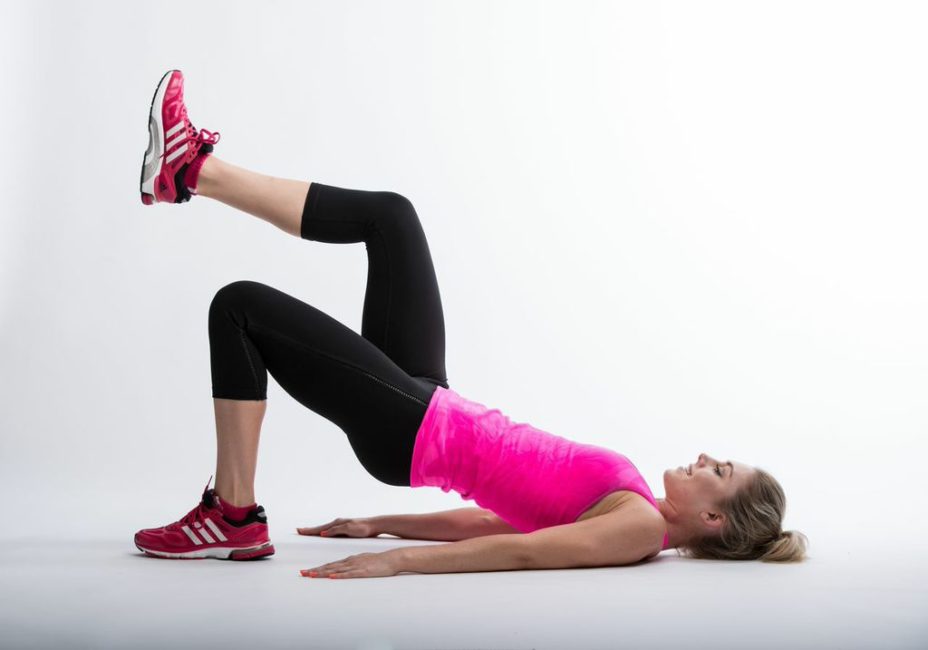The Art of Perfecting the Single-Leg Glute Bridge
Doing glute bridges is a great way to work out your backside, which is important for the overall strength of your body. Also, if you are looking to firm up your booty, doing this exercise is a must.
However, doing just single-leg glute bridges could be even better for you than doing them with both legs. Using just one leg will not only helps you isolate the glute muscles, it will also incorporate your other back muscles, making this move an intense one to add to your workout routine.
But how do you do this exercise with just one leg?
First, you lie on your back with your knees bent and your feet shoulder-width apart. Make sure your feet are about a foot away from your glutes. Lift your left leg straight up into the air with your foot flexed and that knee locked, creating a straight line between your hip and heel. This leg should not move at all, but remain fixed in this position. If it moves at all, you are creating “lift” via the momentum of that moving left leg, so KEEP it still.
While you’re keeping your upper back flat on the floor, tighten your glute muscles and raise your hips up off of the ground via your right heel–high enough so that your body forms a straight line, via your right knee, hip and shoulder. Make sure that you are keeping your core muscles engaged while doing this exercise. Once your body is up and in a straight line, pause for a moment, squeezing your glutes for a few seconds. Return to your starting position to complete one rep. Once you have done all of your reps, repeat the exercise with the other leg.
To get the best results, do sets of 15 or 20 reps if you are not adding any weight. If you are adding weight, do about 12 reps. Make sure that you rest for at least 30 seconds between each set in order to let your body recover.
When it comes to your form, make sure that you extend your hips fully when you reach the top of your movement. Also, when you push yourself up, use the muscles via your heels and hips rather than those from your legs. Your heel drives your hamstrings and your glutes, while the ball of the foot tends to engage the quads more. So think and feel “heels.” Also, remember that the engagement of your muscles, along with the pause at the top of your movement, are a critical part of fully engaging your muscles, i.e., peak contraction.
Doing single-leg bridges has several benefits to your physical health. Similar to when you do a standard glute bridge. The single-leg type targets all of your glute muscles, which includes the maximus, medius, and minimus. However, lifting one leg makes your hamstrings and lower back do work as well, which makes this move more intense than when you do it with both legs.
Doing this exercise will build both functionality and aesthetics. This is a great exercise for those who have to work behind a desk all day or who are otherwise sedentary. It helps to improve your hip mobility and your lower back strength, which counters the negative impacts of sitting at a desk.
Doing these single-leg glute bridges are difficult to do without any weight, but once you get the hang of it and build more strength in these muscles, you can start to add some weight, like a dumbbell or a barbell across your hips, to increase the intensity of the exercise.
Start doing these exercises a few times a week without adding weights at first. As you begin to master this movement and build up your strength, you can start adding some weight, but do it slowly. Decrease the frequency of doing this exercise to just once each week to slowly build your glutes, while also allowing them to have the necessary time to recover. Just like with other exercises, doing this at a healthy pace will help you avoid becoming injured or too sore.
There are other variations of this exercise that you can do as well. You can do an elevated single-leg glute bridge by doing this same movement but with one foot on the floor and one foot lifted up on a bench. Or you could do a banded single-leg glute bridge, which will add resistance to your thighs.
You can also do this exercise on a bench by placing your upper back on a bench with one foot on the ground and the other extended at the height of your hips. Then, lower your hips and press up with your feel and squeeze your glute muscles. Return to your starting position and repeat.
However you decide to do this move, you will definitely start to feel the effects of it on your glutes.
Fitness Together Mission Hills offers personal training with qualified professionals by regular appointment in private suites. Exercise and nutritional programs are custom designed to fit your needs and abilities. Call 619-794-0014 for more information or to schedule a free fitness diagnostic and private training session. See what others are saying about us on Yelp.

Category: Business, Health & Fitness







